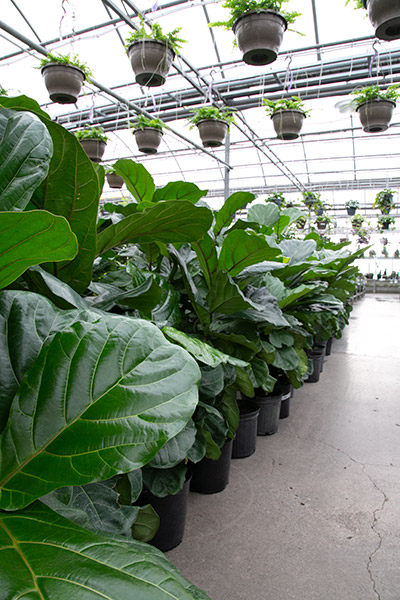HOUSEPLANTS
FIDDLE-LEAF FIGS
Ficus lyrata
Native to West Africa, the fiddle-leaf fig is a popular ornamental tree in warmer climates where it can grow up to 50 feet tall! In colder climates, it has quickly become one of the most popular houseplants due to its large fiddle-shaped leaves and tall growth habit.
The Ficus genus as a whole love consistency, so pick a spot in your home where they will be happiest and leave them there! Fiddle-leaf figs will drop leaves when things change or when stressed, and they can be stressed very easily. These are definitely not a houseplant for beginners but can be very rewarding if you have the right spot and can keep them happy! Remember, re-pot only when necessary and try to keep a regular watering schedule.
Light
Like most tropical plants, fiddle-leaf figs prefer bright, indirect light. For indirect light, your plant should be able to see as much of the sky as possible, without seeing the sun. This is typically a space within 2-5 feet of a large window. They can handle some direct sunlight, but too much exposure can burn their leaves, and they do not tolerate low light spaces.
Water

To keep things basic, you should water your fiddle-leaf fig when the top ¼ of your pot is dry (you can check by sticking your finger deep into the soil). Don’t let the soil dry out entirely, but if your plant is still moist on top, skip that watering! Keep in mind, the frequency of watering may vary throughout the year as the seasons, temperature, and the amount of light your plant is receiving changes. They will need much less water in the winter months when the days are shorter and there is limited sunlight. Figuring out a watering schedule can be challenging for these plants so don’t get discouraged if it takes a little time!
Another aspect of watering that should be considered is mineral deposits or additives in your water source. Only some species are sensitive to it, and fiddle-leaf figs certainly fall into that category. Minerals and salts build up in the soil and can cause brown spots to appear on the leaves. To prevent this unsightly issue, you can “flush” the plant every few months to reduce the amount of salts in the soil by sitting the plant in a sink and running the tap over it for a few minutes (just make sure your pot has drainage holes for the water to drain from the growing medium. The other option is to use distilled or rain water on them to avoid it entirely!
Temperature & Humidity
Fiddle-leaf figs do best in temperatures between 15-24°C, which is fairly standard for most homes. They do not tolerate cold drafts whatsoever, so be aware of any vents, open windows, or doors in the winter time. They are not as fussy when it comes to humidity as other houseplants, but they can benefit from increased humidity in the winter months when our homes tend to be on the drier side. If your fiddle-leaf fig is suffering from too low of humidity levels, you will see brown tips or edges appearing or entire leaves drying up. Remember that drying leaves can also be a sign of under watering as well!
Fertilizer
Fertilize throughout the growing season (generally May to September) with a regular houseplant fertilizer and follow the directions on the package to feed the correct amount. You should not fertilize during the fall and winter months as plants are not actively growing and need a dormancy or rest period. If you are seeing lots of active growth and newly emerging leaves in the dormancy period, you could do one application of fertilizer to support the new growth.
Growing Mediums & Repotting
For fiddle-leaf figs, you can either use a regular or a tropical potting soil. You can incorporate additional perlite and/or orchid bark to your soil to help reduce soil compaction and increase aeration, but keep in mind this will likely increase how frequently you need to water. Remember that fiddle-leaf figs don’t like change so only re-pot when absolutely necessary, which will be indicated by coiling roots or large quantities of roots emerging from drainage holes at the bottom of the pot. When you decide it’s time, remember that your new pot should only be 1-2” larger than your previous pot and it is best to repot during the active growing season (spring or summer)!




